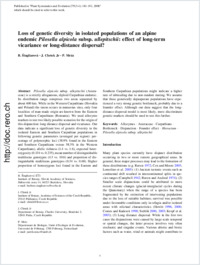Loss of genetic diversity in isolated populations of an alpine endemic Pilosella alpicola subsp. ullepitschii : effect of long-term vicariance or long-distance
- Šingliarová, Barbora Institute of Botany, Academy of Sciences, Bratislava, Slovakia
- Chrtek, Jindřich Institute of Botany, Academy of Sciences, Pruhonice, Czech Republic - Department of Botany, Charles University, Praha, Czech Republic
- Mráz, Patrik Département de Biologie, Unité d`Ecologie & Evolution, Université de Fribourg, Switzerland
-
19.08.2008
Published in:
- Plant Systematics and Evolution. - 2008, vol. 275, no. 3-4, p. 181-191
Allozymes
Asteraceae
Carpathians
Bottleneck
Disjunction
Founder effect
Hieracium
Pilosella alpicola subsp. ullepitschii
English
Pilosella alpicola subsp. ullepitschii (Asteraceae) is a strictly allogamous, diploid Carpathian endemic. Its distribution range comprises two areas separated by about 600 km. While in the Western Carpathians (Slovakia and Poland) the taxon occurs in numerous sites, only four localities of man-made origin are known from the Eastern and Southern Carpathians (Romania). We used allozyme markers to test two likely possible scenarios for the origin of this disjunction: long distance dispersal and vicariance. Our data indicate a significant loss of genetic diversity in the isolated Eastern and Southern Carpathian populations in following genetic parameters (averaged per region): percentage of polymorphic loci (38.9% found in the Eastern and Southern Carpathians versus 58.3% in the Western Carpathians), allelic richness (1.4 vs. 1.6), expected heterozygosity (0.134 vs. 0.235), mean number of distinguishable multilocus genotypes (4.3 vs. 10.6) and proportion of distinguishable multilocus genotypes (0.34 vs. 0.68). Higher proportion of homozygous loci found in the Eastern and Southern Carpathian populations might indicate a higher rate of inbreeding due to non-random mating. We assume that these genetically depauperate populations have experienced a very strong genetic bottleneck, probably due to a founder effect. Although our data suggest that the long-distance dispersal model is most likely, more discriminate genetic markers should be used to test this further.
- Faculty
- Faculté des sciences et de médecine
- Department
- Département de Biologie
- Language
-
- English
- Classification
- Biological sciences
- License
-
License undefined
- Identifiers
-
- RERO DOC 11255
- DOI 10.1007/s00606-008-0058-3
- Persistent URL
- https://folia.unifr.ch/unifr/documents/300996
Statistics
Document views: 139
File downloads:
- pdf: 166
